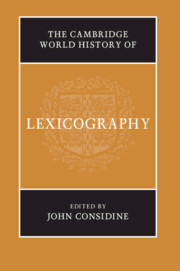Book contents
- The Cambridge World History of Lexicography
- The Cambridge World History of Lexicography
- Copyright page
- Contents
- Contributors
- Editor’s Acknowledgements
- Introduction
- Part I The Ancient World
- Part II The Pre-Modern World
- Part III The Modern World: Continuing Traditions
- Part IV The Modern World: Missionary and Subsequent Traditions
- 26 Missionary Traditions in South America
- 27 Missionary Traditions in Mesoamerica
- 28 Missionary and Subsequent Traditions in North America
- 29 Missionary Traditions in East Asia
- 30 European Traditions in India and Indonesia
- 31 Missionary and Subsequent Traditions in Africa
- 32 Missionary and Other Traditions in Australia
- Appendix 1 The Language Varieties
- Appendix 2 The Lexicographers
- Primary Sources
- Secondary Sources
- Index
26 - Missionary Traditions in South America
from Part IV - The Modern World: Missionary and Subsequent Traditions
Published online by Cambridge University Press: 01 September 2019
- The Cambridge World History of Lexicography
- The Cambridge World History of Lexicography
- Copyright page
- Contents
- Contributors
- Editor’s Acknowledgements
- Introduction
- Part I The Ancient World
- Part II The Pre-Modern World
- Part III The Modern World: Continuing Traditions
- Part IV The Modern World: Missionary and Subsequent Traditions
- 26 Missionary Traditions in South America
- 27 Missionary Traditions in Mesoamerica
- 28 Missionary and Subsequent Traditions in North America
- 29 Missionary Traditions in East Asia
- 30 European Traditions in India and Indonesia
- 31 Missionary and Subsequent Traditions in Africa
- 32 Missionary and Other Traditions in Australia
- Appendix 1 The Language Varieties
- Appendix 2 The Lexicographers
- Primary Sources
- Secondary Sources
- Index
Summary
The story of missionary lexicography in South America begins in the sixteenth century, with the Spanish–Quechua and Quechua–Spanish Lexicon, o Vocabulario de la lengua general del Peru of the Dominican friar Domingo de Santo Tomás, published in 1560; its first section contains about 6,000 entries, and its second about 4,000. Quechua had been the language of the Inca empire, and continued in widespread use after the fall of that empire, so that it was an important subject for dictionaries. The work of Santo Tomás was followed in 1586 by an anonymous Arte y vocabulario en la lengua general del Peru, presenting adaptations of his two wordlists (about 5,000 entries each) followed by a grammar.
- Type
- Chapter
- Information
- The Cambridge World History of Lexicography , pp. 555 - 578Publisher: Cambridge University PressPrint publication year: 2019
- 1
- Cited by

